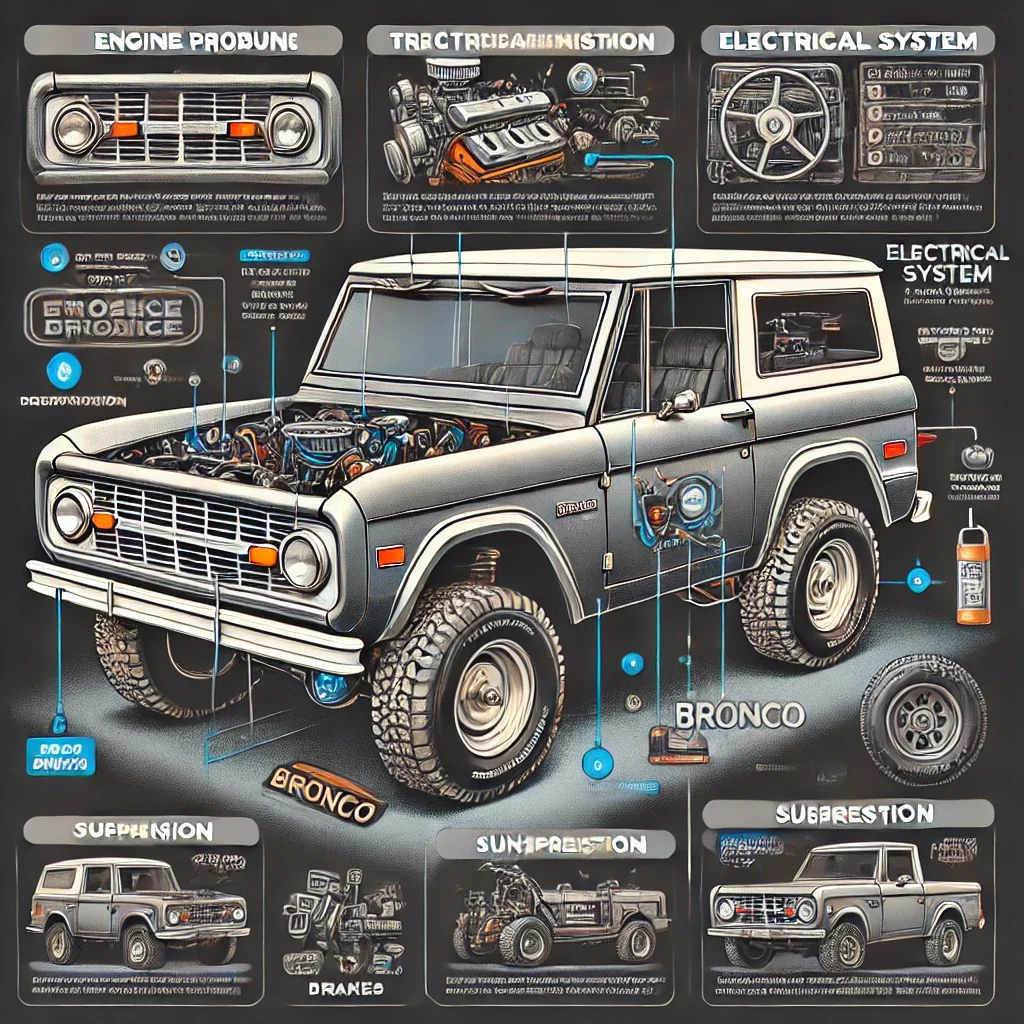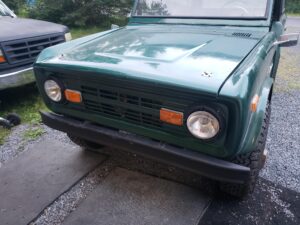Troubleshooting and Fixing Common Issues in a Classic Ford Bronco

Introduction
Owning a classic Ford Bronco (1980-1990) is a rewarding experience, but like any vintage vehicle, it may develop issues over time. From engine problems to electrical malfunctions, this guide provides a detailed approach to diagnosing and fixing common problems to keep your Bronco running smoothly.
1. Engine Issues
Problem: Engine Won’t Start
- Possible Causes:
- Weak or dead battery.
- Faulty starter motor or solenoid.
- No fuel delivery due to a failing fuel pump or clogged filter.
- Ignition system failure (e.g., faulty spark plugs or distributor).
- Fix:
- Check the battery voltage; replace if below 12.4V.
- Inspect and replace the starter motor or solenoid.
- Verify fuel delivery by checking the pump and filter.
- Test the ignition system and replace faulty components like spark plugs or the distributor cap.
Problem: Rough Idle or Stalling
- Possible Causes:
- Vacuum leaks.
- Clogged carburetor or injectors.
- Worn ignition components.
- Fix:
- Inspect vacuum hoses for cracks or disconnections and replace as needed.
- Clean the carburetor or use a fuel injector cleaner.
- Replace spark plugs, ignition wires, and distributor components.
Problem: Overheating
- Possible Causes:
- Low coolant levels or leaks.
- Malfunctioning thermostat or water pump.
- Clogged radiator.
- Fix:
- Check and refill coolant, repairing leaks if found.
- Replace the thermostat and inspect the water pump for proper operation.
- Flush the radiator or replace it if clogged.
2. Transmission and Drivetrain Issues
Problem: Difficulty Shifting Gears
- Possible Causes:
- Low transmission fluid.
- Worn clutch (manual) or damaged shift solenoids (automatic).
- Misaligned shift linkage.
- Fix:
- Check and top off transmission fluid.
- Replace the clutch or solenoids if worn.
- Adjust or replace the shift linkage.
Problem: Vibration While Driving
- Possible Causes:
- Unbalanced driveshaft.
- Worn U-joints.
- Misaligned axles.
- Fix:
- Balance the driveshaft.
- Replace worn U-joints.
- Align the axles to factory specifications.
3. Electrical System Issues
Problem: Dead Battery or Alternator Issues
- Possible Causes:
- Weak battery or failing alternator.
- Corroded terminals or loose connections.
- Fix:
- Test the battery and alternator output. Replace if necessary.
- Clean terminals and tighten connections.
Problem: Non-Functioning Lights
- Possible Causes:
- Blown fuses or relays.
- Faulty light switch or wiring.
- Fix:
- Replace blown fuses or relays.
- Inspect and replace damaged switches or repair wiring.
Problem: Intermittent Electrical Failures
- Possible Causes:
- Loose ground connections.
- Faulty wiring harness.
- Fix:
- Tighten all ground connections.
- Replace damaged sections of the wiring harness.
4. Suspension and Steering Issues
Problem: Loose Steering
- Possible Causes:
- Worn steering box or tie rods.
- Damaged ball joints.
- Fix:
- Adjust or replace the steering box.
- Replace worn tie rods and ball joints.
Problem: Excessive Body Roll
- Possible Causes:
- Worn stabilizer bars or bushings.
- Fix:
- Inspect and replace stabilizer bars and bushings.
5. Brake System Issues
Problem: Spongy Brake Pedal
- Possible Causes:
- Air in the brake lines.
- Worn brake pads or shoes.
- Fix:
- Bleed the brake lines to remove air.
- Replace worn brake pads or shoes.
Problem: Uneven Braking
- Possible Causes:
- Warped rotors or drums.
- Sticking calipers.
- Fix:
- Replace warped rotors or drums.
- Rebuild or replace sticking calipers.
6. Fuel System Issues
Problem: Engine Hesitation or Stalling
- Possible Causes:
- Clogged fuel filter.
- Weak fuel pump.
- Fix:
- Replace the fuel filter.
- Test and replace the fuel pump if necessary.
Problem: Fuel Odor
- Possible Causes:
- Leaking fuel lines or tank.
- Fix:
- Inspect and repair leaking fuel lines or replace the tank if damaged.
7. Preventative Maintenance Tips
- Regular Fluid Checks:
- Inspect and replace engine oil, transmission fluid, coolant, and brake fluid.
- Inspect Hoses and Belts:
- Replace cracked or worn hoses and drive belts.
- Test the Battery and Charging System:
- Ensure the battery and alternator are functioning properly.
- Lubricate Moving Parts:
- Grease suspension and steering components regularly.
- Clean and Protect:
- Wash the undercarriage and apply rust inhibitors to prevent corrosion.
Conclusion
Troubleshooting and fixing issues in a classic Ford Bronco can be a straightforward process with the right tools, knowledge, and parts. By addressing problems early and performing regular maintenance, you can keep your Bronco running reliably for years to come. Let me know if you’d like a more specific guide for any particular issue!


